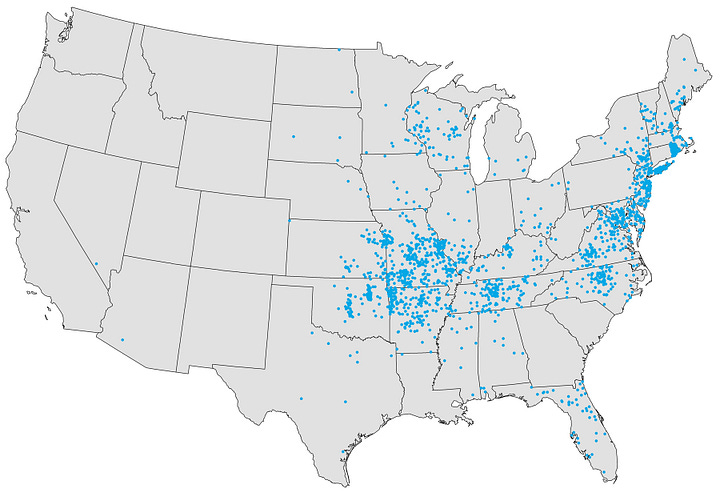Happy June! During the summer months, I am providing updates on what’s going around once per month. Weekly updates will resume in October (or earlier if the needed arises because of e.g., a covid wave). I also have a reader poll at the end of today’s newsletter, so please check it out and cast a vote.
This time of year my biggest concerns for the United States are tick-borne diseases, waterborne illness, and a summer COVID-19 wave. Let’s take a quick tour.
Tickborne diseases
There are tons of different tick-borne diseases, all of them bad news. I won’t go through all of them here, but there’s a few important points you need to know.
Lyme disease, transmitted primarily by black-legged ticks, is the most common tickborne illness that you need to be aware of. The highest number of reported cases is concentrated in the northeastern states and the upper midwestern states, but it’s found all over the eastern half of the country. Anaplasmosis and babesiosis have a similar geographic distribution as Lyme.

Other notable diseases include spotted fever rickettsiosis and ehrlichiosis, which are less common but have a wider distribution. Spotted fever causes fever, headache, and rash and ehrlichiosis causes fever, chills, headache, muscle aches, and sometimes upset stomach. CDC has plenty of details, if you want to learn more about the many and various other tickborne diseases.


Prevention: Wear protective clothing and use insect repellents containing DEET when you are outdoors, especially in the woods or areas with brush or high grass. After outdoor activities, make sure to thoroughly check your body for ticks and promptly remove any that are attached. Also make sure you are in touch with your veterinarian about tick prevention for pets. Not only can animals get tickborne diseases themselves, but they can also carry ticks into the house.
Treatment: If you find an attached tick, get yourself over to this PDF for removal and follow-up instructions.
Waterborne diseases
Summertime is also associated with waterborne illnesses, particularly when swimming in lakes, rivers, and other recreational water bodies. Common waterborne illnesses in the summer include gastrointestinal infections caused by bacteria like E. coli, norovirus, and shigella, as well as parasitic infections like cryptosporidium and giardia. Splash pads, hot tubs, and under-treated pools are also risky.
Prevention: To prevent waterborne diseases, choose recreational water sources carefully and be aware of any recent water quality advisories or closures. Avoid swallowing water while swimming and encourage children to do the same. Shower after swimming to remove any potential pathogens from your skin. Do not go swimming if you have diarrhea or other symptoms of infection.
Treatment: Some waterborne diseases can be treated with medication, and some cannot. If you develop diarrhea after swimming in an untreated water source, contact your doctor for specific guidance. Regardless, staying hydrated is always a priority for diarrheal diseases.
Respiratory diseases and mpox
COVID-19 hospitalizations and deaths continue to decline. Previous summers have seen waves beginning in the southern region of the country and spreading nationwide from there, so I’m keeping monitoring wastewater data for signs of increase. So far, so good.
Influenza like illness (ILI) season is done. Nationally, we’re hanging out at around 2% of visits to the doctor for fever and cough or sore throat. This is typical for the off-season. I don’t expect ILI to pick up again until October, earliest.
Seasonal coronaviruses and RSV activity is low.
I do have some concerns about adenovirus. Both CDC and Biofire show an uptick. Adenoviruses can cause a whole range of symptoms, from respiratory infections to GI illness. Outbreaks are sometimes associated with congregate settings like dorms and barracks, so this time of year I’d be thinking about summer camps. Proper ventilation and spacing between beds can help.
A cluster of around 20 mpox cases in the Chicago area raised concerns that mpox may resurge this summer, but so far the number of new cases nationwide remains low.
Food recalls
The following foods are being recalled because they are contaminated. Please check your cupboards and throw out any of these items:
Raw cookie dough from Papa Murphy’s (more info)
Gold Medal flour, bleached and unbleached all purpose (more info)
Sophelise cheese and Tobasi cheese sold in Massachusetts and New York (more info)
Reader poll
Looking ahead to the next flu season, I’m considering creating regional versions of my This week in outbreaks series (example here). The epidemiological data I use is only detailed enough for me to consider offering four regions: west, midwest, south and northeast. Readers, would you be interested in a regional update on what’s going around?
Edited to add: I would still publish a free national version. Regional would be an additional offering and likely paywalled because I would need a research assistant.





Very much appreciate your valuable information
Great summary. And, visiting my mother-in-law, the cookie dough warning was pertinent and timely (and it's now gone).
I'm personally interested in a national summary, but if regions were summarized, I think the info would be useful. Of course, I'd get all the regions, as my scope for the organization I work with is national but regionalization (something I need to do for the org) would be helpful...
The poll errored when I tried to make an entry, FYI.